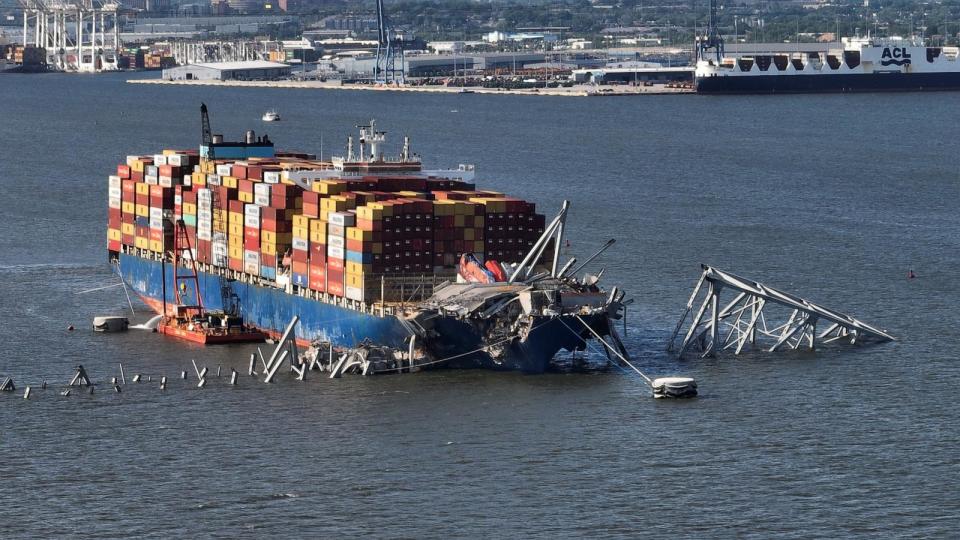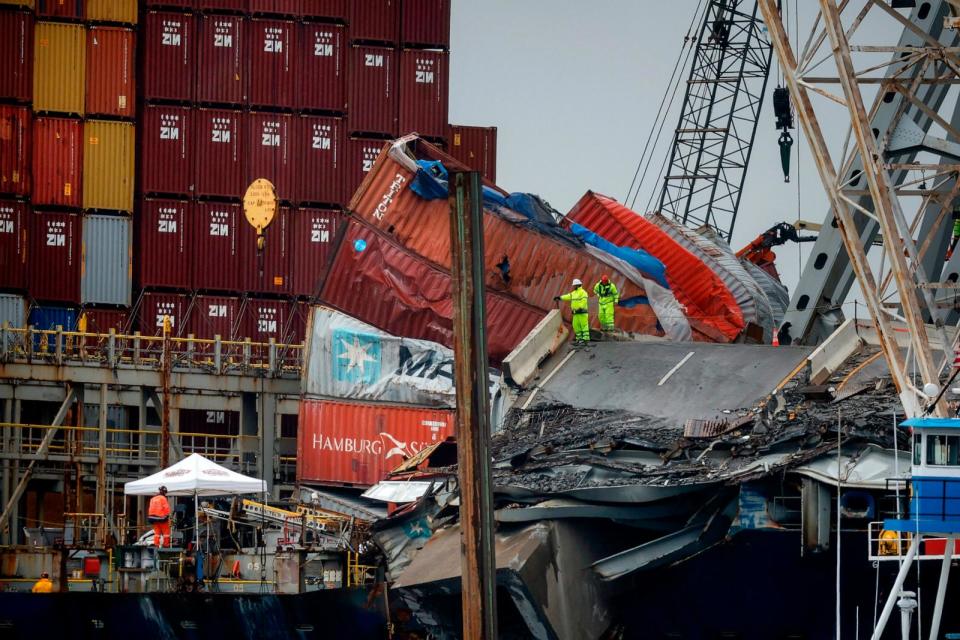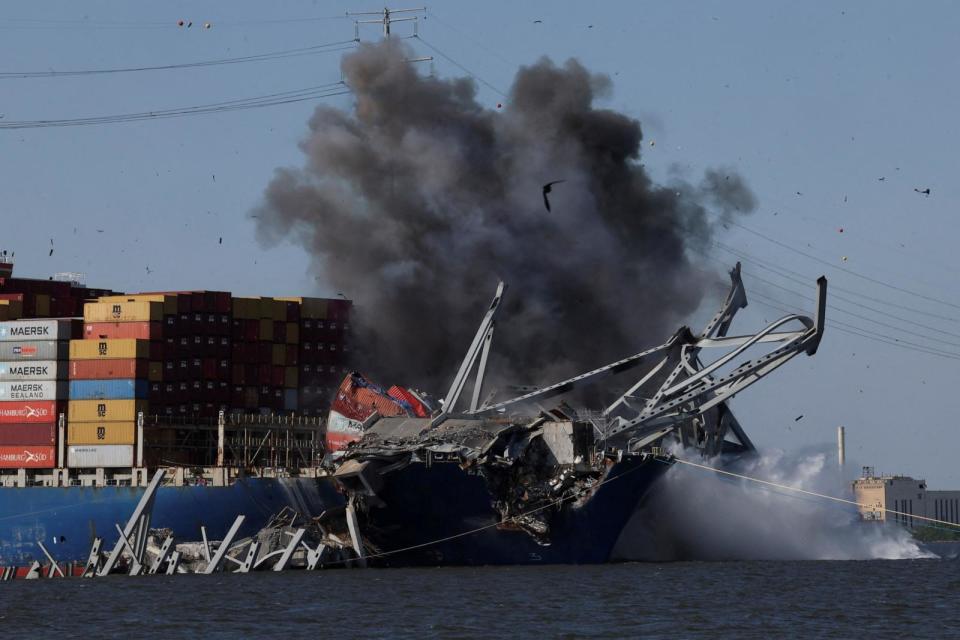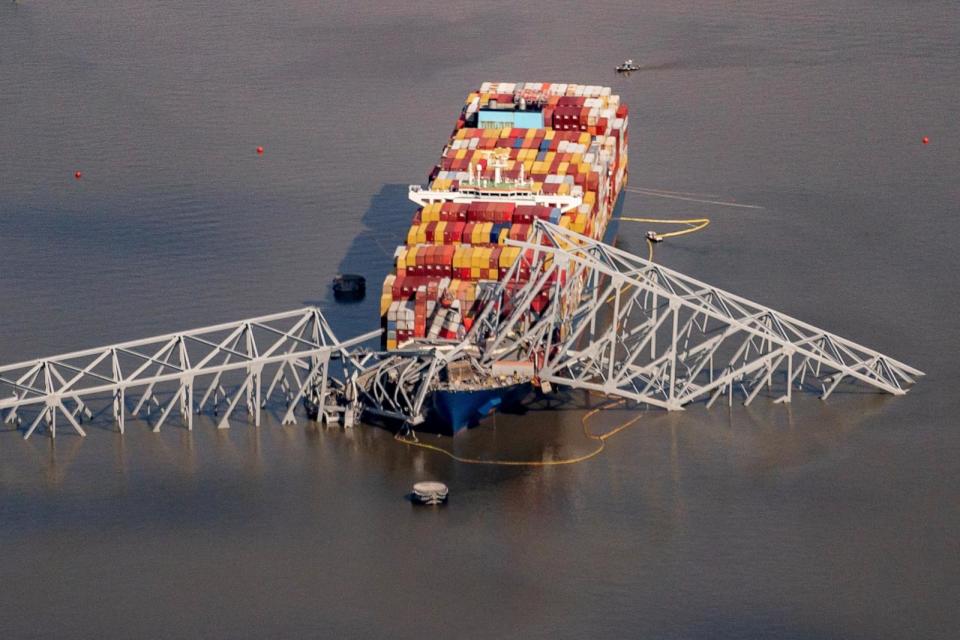Ship that struck Francis Scott Key Bridge had blackouts 10 hours before crash, NTSB report finds
The shipping vessel that crashed into the Francis Scott Key Bridge in March experienced two power blackouts while docked, 10 hours before the collision that toppled part of a bridge span, according to a preliminary report released Tuesday by the National Transportation Safety Board (NTSB).

Federal investigators say fuel tests did not show any irregularities and they are now focusing their probe on the ship's electrical system. Additionally, transportation officials revealed Wednesday that they expect the bridge to be reconstructed by 2028, at the earliest.
Blackouts before departure
The container ship M/V Dali experienced two blackouts on March 25 while the Sri Lankan-based vessel was undergoing maintenance at the Seagirt Marine Terminal in Baltimore Harbor, the NTSB report said.
MORE: Baltimore bridge collapse timeline: Inside the cargo ship collision
A crew member mistakenly closed an inline engine exhaust damper for one of the vessel's four diesel generators, which blocked the engine's exhaust gases from exiting the vessel, according to the NTSB. That, in turn, caused the engine to stall and diesel generators to stop working, the report said.
When the Dali's systems detected the power loss, another generator started, according to the NTSB report.
Crews were able to get the first generator back online. However, a second blackout occurred minutes later when "insufficient fuel pressure caused [the second generator's] speed to decrease, and its breaker ... opened," causing another blackout, according to the NTSB.
After crews were able to re-open the exhaust damper for the first malfunctioning generator, it automatically restarted and power was restored, the report said.
Blackouts hit moments before the crash
The Dali left the port in the early-morning hours of March 26 but close to 1:28 a.m., which is the time it collided with the Francis Scott Key Bridge, it experienced two more blackouts.

The first power loss shut down the main engine and caused its propeller to stop, according to the NTSB. The crew was able to restore power, but then the ship lost power again moments later when it was approaching the bridge, according to the NTSB.
"The NTSB is still investigating the electrical configuration following the first in-port blackout and potential impacts on the events during the accident voyage," the report said.
There were no reported blackout incidents recorded when the Dali was docked at ports in Newark, New Jersey and Norfolk, Virginia during its recent U.S. voyage, according to the NTSB.
MORE: Francis Scott Key Bridge wreckage demolished in controlled explosion after delays
Video of the incident showed the lights on the Dali extinguishing and smoke emanating from the ship before it crashed into the bridge, causing a partial collapse.
The aftermath
Crews onboard the container ship were able to warn officials about the malfunction, giving them time to close the bridge to oncoming traffic before the crash. However, six men, who were working on the bridge were unable to escape and were killed in the bridge collapse.
During a Wednesday House Transportation and Infrastructure Committee hearing about the crash, NTSB Chairwoman Jennifer Homendy said 52 seconds elapsed between the ship pilot's call to the bridge's operators and the bridge's closure.
"If you just look at the time, from the blackout to the bridge strike, it was four minutes total," she testified.

The crash affected entry into the Port of Baltimore for weeks as the debris blocked entry for other ships.
NTSB investigators are still onboard the M/V Dali conducting their probe. Homendy noted that it's highly unusual for them to stay aboard for so long.
The final NTSB report with the cause of the incident could take up to two years to complete.
The Dali has remained stuck at the crash site but recovery teams made progress this week after they set off controlled explosions Monday to remove the section of the bridge that was attached to the ship.
Vice Admiral Peter Gautier, the deputy commandant for operations for the U.S. Coast Guard, told the committee that the Dali is expected to be moved away from the site as early as next week.
The restoration of the Francis Scott Key Bridge will take longer and come at a hefty price, according to officials. Shailen Bhatt, administrator for the Department of Transportation (DOT) Federal Highway Administration, told the committee that the current timetable has construction work on the bridge scheduled to commence next year and last until 2028.

According to the cost estimates provided by the Maryland government, the bridge's reconstruction will cost between $1.7 to $1.9 billion, Bhatt said. Maryland has one insurance policy of $350 million on the bridge, which was constructed without federal funding, the DOT official said.
Since the bridge collision, the DOT has provided $60 million in emergency relief funds and the Coast Guard has spent a further $20 million in direct and indirect funding as part of the clean-up and recovery efforts, Bhatt testified.
Ship that struck Francis Scott Key Bridge had blackouts 10 hours before crash, NTSB report finds originally appeared on abcnews.go.com

